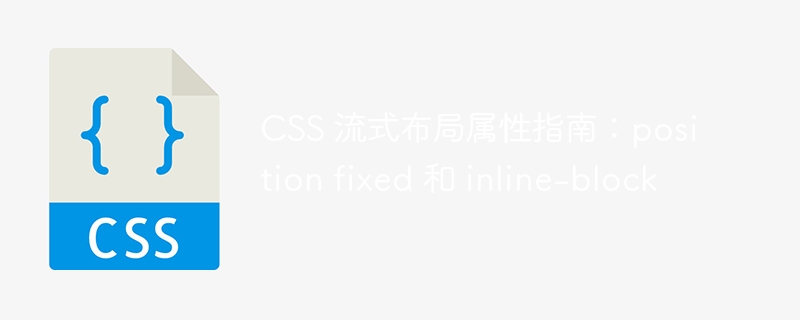Home >Web Front-end >CSS Tutorial >A guide to CSS fluid layout properties: position fixed and inline-block
A guide to CSS fluid layout properties: position fixed and inline-block
- 王林Original
- 2023-10-21 09:56:03982browse

CSS Fluid Layout Property Guide: position fixed and inline-block
In web design, it is very important to achieve fluid layout. Fluid layout allows the web interface to adapt to different devices under different screen sizes, providing a better user experience. In CSS, there are many properties that can achieve fluid layout, among which position fixed and inline-block are two commonly used properties. This article describes these two properties along with specific code examples.
1. Position fixed
The position fixed attribute is a positioning attribute in CSS. By setting the positioning method of the element to fixed positioning, the element can be displayed at a fixed position on the page. When the page scrolls, the element does not change position as the page scrolls.
The following is the general syntax of the position fixed attribute:
.selector {
position: fixed;
top: 0;
left: 0;
}Among them, .selector represents the element to which this attribute is applied, and top and left are used to set the distance of the element from the top and left. By setting different values, you can control the specific position of the element on the page.
The application scenarios of the position fixed attribute are very wide. For example, using position fixed in the head navigation bar of a web page can keep the navigation bar in a fixed position when the page is scrolled, making it easier for users to navigate quickly.
The following is a specific code example that demonstrates how to use position fixed to implement a fixed navigation bar:
<!DOCTYPE html>
<html>
<head>
<style>
.navbar {
position: fixed;
top: 0;
left: 0;
width: 100%;
background-color: #333;
color: #fff;
padding: 10px;
}
.content {
padding-top: 50px;
}
</style>
</head>
<body>
<div class="navbar">这是一个固定的导航栏</div>
<div class="content">
<h1>内容区域</h1>
<p>这是一个网页的内容部分。</p>
</div>
</body>
</html>In the above example, the navigation bar is made by setting the position of .navbar to fixed. Pinned to the top of the page. In the content part, the padding-top is set to a value equal to the height of the navigation bar to prevent the content from being covered by the navigation bar.
2. inline-block
The inline-block attribute is a display attribute in CSS. By setting the display attribute of an element to inline-block, you can make the element appear as an inline block-level element. way to display.
The following is the general syntax of the inline-block attribute:
.selector {
display: inline-block;
width: 100px;
height: 100px;
background-color: #f00;
margin: 10px;
}Among them, .selector represents the element to which this attribute is applied, width and height are used to set the width and height of the element, and background-color It is used to set the background color of the element, and margin is used to set the spacing between elements.
The inline-block attribute is often used to implement multi-column layout, especially when it is inconvenient to use the float attribute. By setting an element to inline-block, you can display multiple elements in a row and maintain their block-level characteristics.
The following is a specific code example that demonstrates how to use inline-block to implement a simple multi-column layout:
<!DOCTYPE html>
<html>
<head>
<style>
.column {
display: inline-block;
width: 200px;
height: 200px;
background-color: #f00;
margin: 10px;
}
</style>
</head>
<body>
<div class="column">Column 1</div>
<div class="column">Column 2</div>
<div class="column">Column 3</div>
</body>
</html>In the above example, by setting the display attribute of the .column element to Inline-block implements three elements to be displayed in one line and maintains block-level characteristics. The width, height, background-color, and margin properties set the size of elements, the background color, and the spacing between elements.
Summary:
This article introduces position fixed and inline-block in CSS fluid layout properties, and provides specific code examples. By understanding and flexibly using these two attributes, you can better control the layout of the web page and provide a better user experience. I hope that readers can master the method of using position fixed and inline-block attributes to achieve fluid layout through studying this article.
The above is the detailed content of A guide to CSS fluid layout properties: position fixed and inline-block. For more information, please follow other related articles on the PHP Chinese website!

